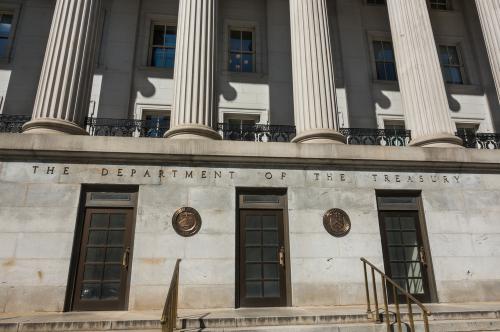What’s the latest thinking in fiscal and monetary policy? The Hutchins Roundup keeps you informed of the latest research, charts, and speeches. Want to receive the Hutchins Roundup as an email? Sign up here to get it in your inbox every Thursday.
Feedback loops between central banks and the private sector can lower long-term real interest rates
Economists generally believe that long-run real interest rates have fallen over time due to underlying trends in fundamentals like demographics and growth that raise savings and lower investment. Phurichai Rungcharoenkitkul of the Bank for International Settlements and Fabian Winkler of the Federal Reserve Board propose an alternate explanation: central bankers may influence the long-run equilibrium interest rate. Many of the underlying factors thought to determine real rates are unobservable, the authors argue, and neither central banks nor the private sector have perfect information about them. Instead, central banks form their expectations for interest rates mostly based on macroeconomic and financial market outcomes, while households and businesses rely on current interest rates and communications from central banks. With both sides basing their actions partly on the other, short-term changes can spiral into a feedback loop that lowers long-term rates independently of underlying economic trends. For example, if a central bank lowers interest rates during a recession, the private sector may assume that the central bank knows that the long-run real rate will fall. When the private sector lowers its expectations for long-run rates, output and inflation fall, causing the central bank to lower rates even further. Not only does this “hall of mirrors” effect help explain falling U.S. interest rates since 2008, the authors say, it also implies that loosening monetary policy to accommodate these lower rates may actually be exacerbating their decline.
Trade competition from China cut union organization efforts across US industries
Using data on U.S. union certification elections, Kerwin Kofi Charles of Yale, Nagisa Tadjfar of MIT, and Matthew S. Johnson of Duke University estimate that there were 4.5% fewer union elections in 1990-2007 in industries exposed to the China Shock than there would have been without a surge in imports from China. Foreign competition likely cut the profitability of firms in those industries, the authors suggest, which reduced the benefits workers expected to secure from collective bargaining. Workers living in areas heavily hit by import competition also faced a weaker labor market, making it riskier for them to attempt unionization regardless of the industry they worked in. A one percentage point increase in the import penetration rate of industries lowered the average number of union elections in the local labor market by 23%, the authors estimate. The results suggest that the rise in international trade and the decline in labor unions – trends linked to the stagnation of U.S. wages in recent decades – “may have interacted with and compounded each other to affect changes in the wage structure,” the authors conclude.
Rent growth has not differed substantially across income groups
Do households at different income levels face different inflation rates? Daryl Larsen and Raven Molloy from the Federal Reserve Board of Governors examine how changes in housing costs — which represent 25% of the household consumption basket in the Consumer Price Index (CPI) — have differed for households across the income distribution. Using data from the American Household Survey from 1985 to 2019, they find that quality-adjusted changes in rent have not differed much by income. Over the entire period, rent increased by 81% for the top quintile of the income distribution, and by 72% for the bottom quintile. Accounting for the fact that lower-income households spend a larger fraction of their consumption on housing, and assuming that prices of other goods do not vary across income groups, they calculate overall CPI inflation rose at very similar rates across the income distribution as well — with overall prices rising 143% for the bottom quintile over the 34-year period and 136% for those in the top quintile. The authors conclude: “More research to understand why differential rent growth across metropolitan areas has not led to material differences in rent growth across the income distribution would be fruitful.”
Chart of the week: Household expectations for inflation climbed in October
Quote of the week:
“Although in a number of sectors of the economy the imbalances between demand and supply — including labor supply — are substantial, I do continue to judge that these imbalances are likely to dissipate over time as the labor market and global supply chains eventually adjust and, importantly, do so without putting persistent upward pressure on price inflation and wage gains adjusted for productivity,” says Richard Clarida, Vice Chair of the Federal Reserve.
“But let me be clear on two points. First, realized PCE [Personal Consumption Expenditures] inflation so far this year represents, to me, much more than a ‘moderate’ overshoot of our 2% longer-run inflation objective, and I would not consider a repeat performance next year a policy success. Second, as always, there are risks to any outlook, and I and 12 of my colleagues believe that the risks to the outlook for inflation are to the upside.”
The Brookings Institution is financed through the support of a diverse array of foundations, corporations, governments, individuals, as well as an endowment. A list of donors can be found in our annual reports published online here. The findings, interpretations, and conclusions in this report are solely those of its author(s) and are not influenced by any donation.
The Brookings Institution is committed to quality, independence, and impact.
We are supported by a diverse array of funders. In line with our values and policies, each Brookings publication represents the sole views of its author(s).







Commentary
Hutchins Roundup: Long-run interest rates, labor unions, and more
November 11, 2021